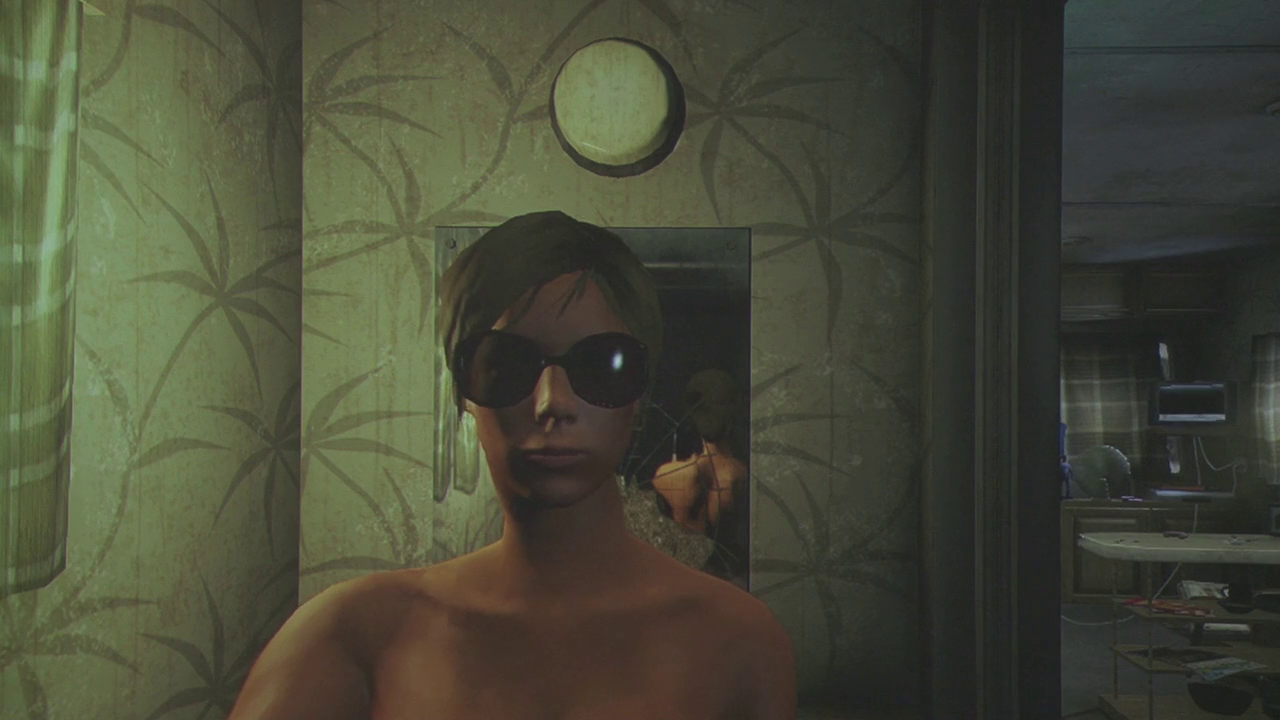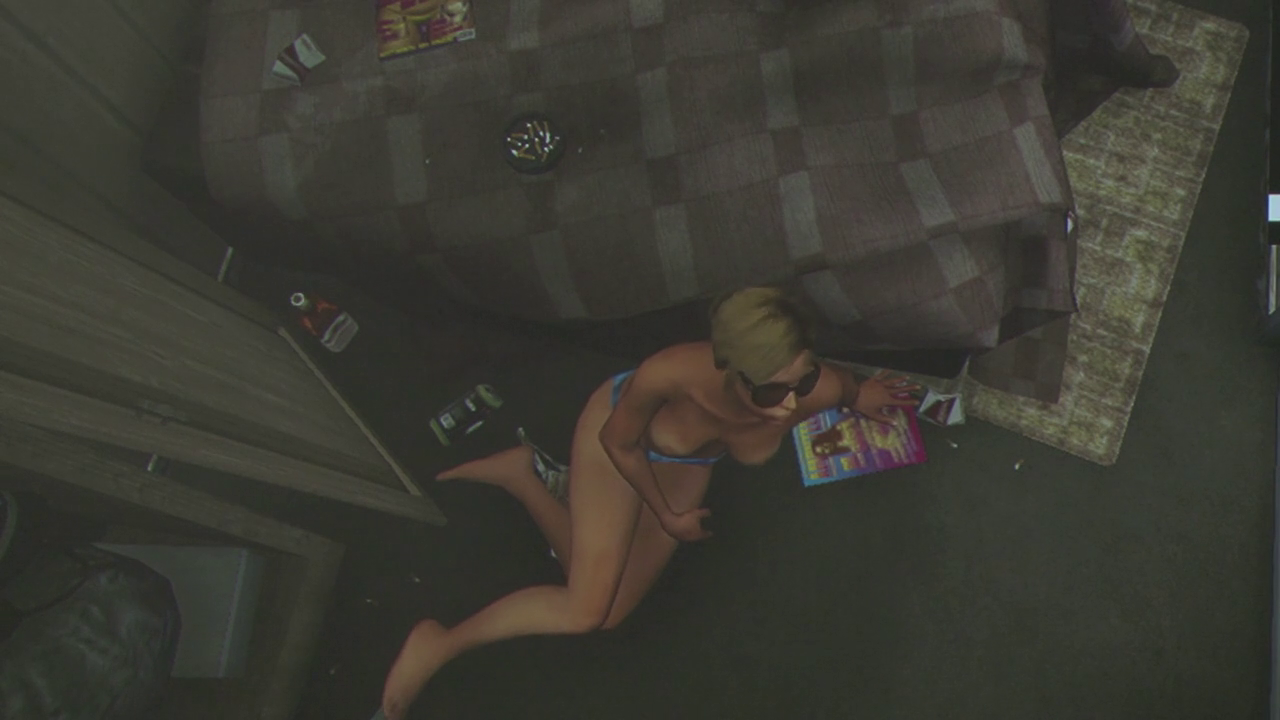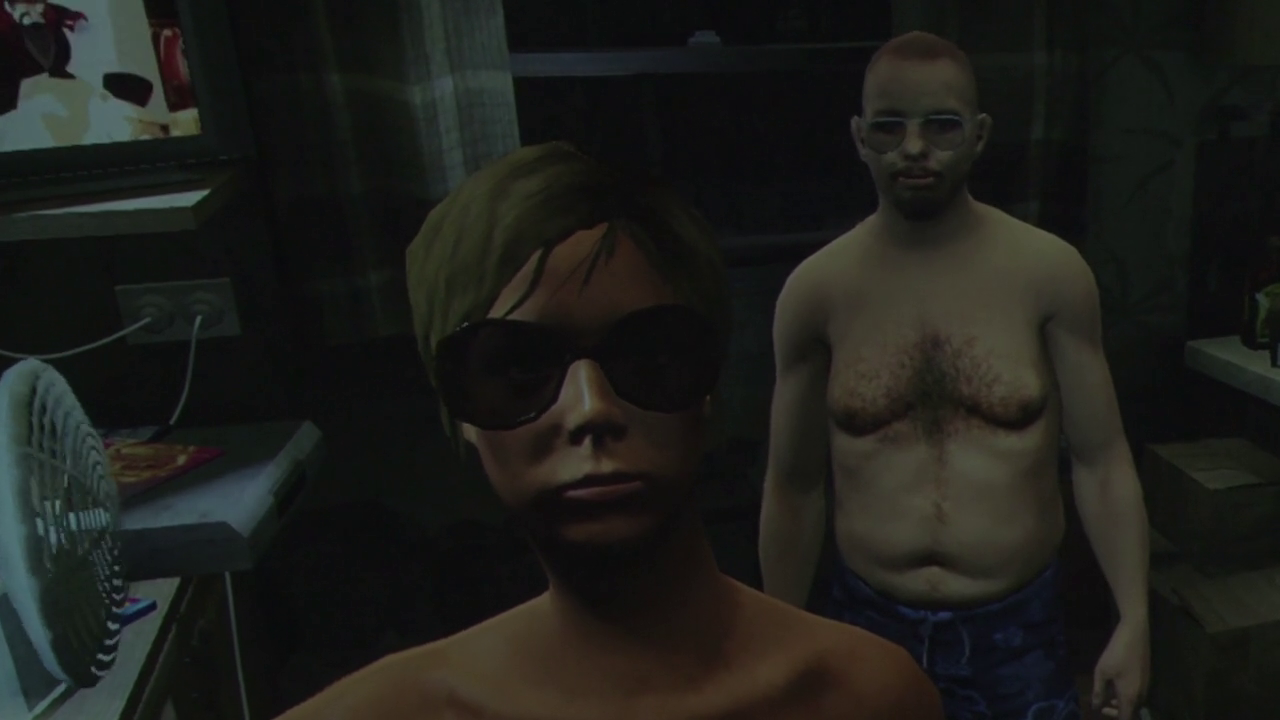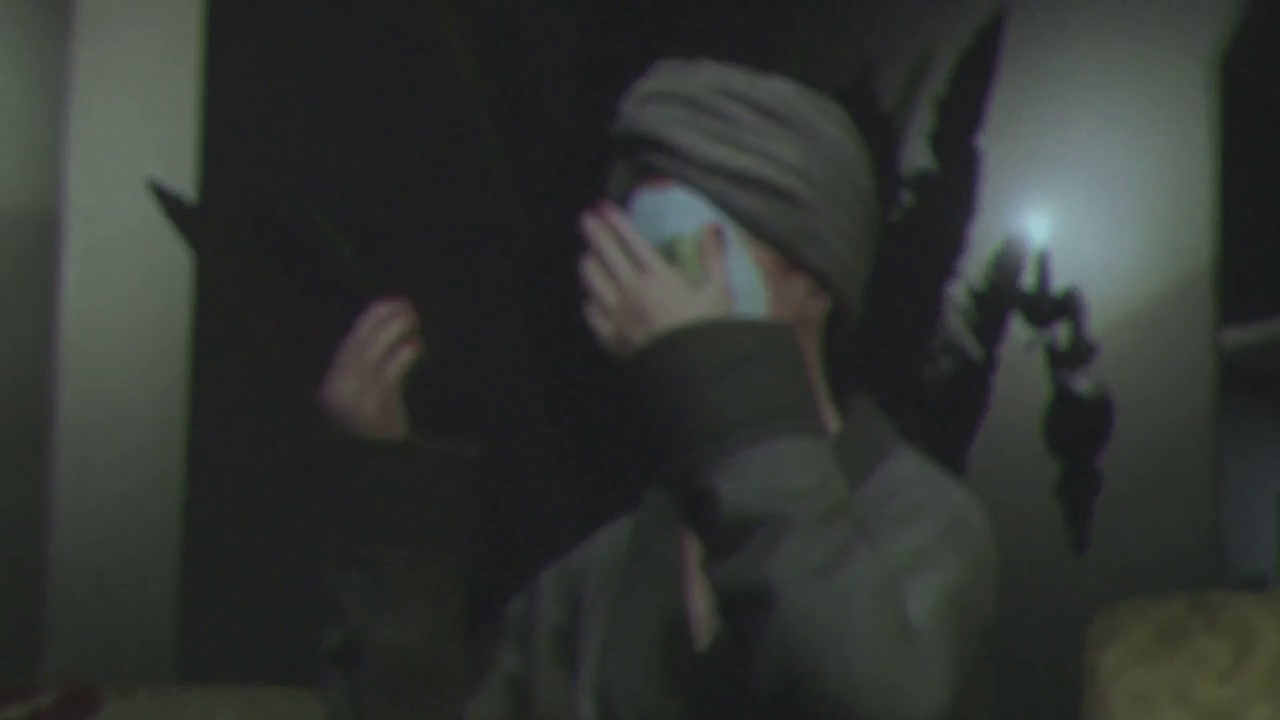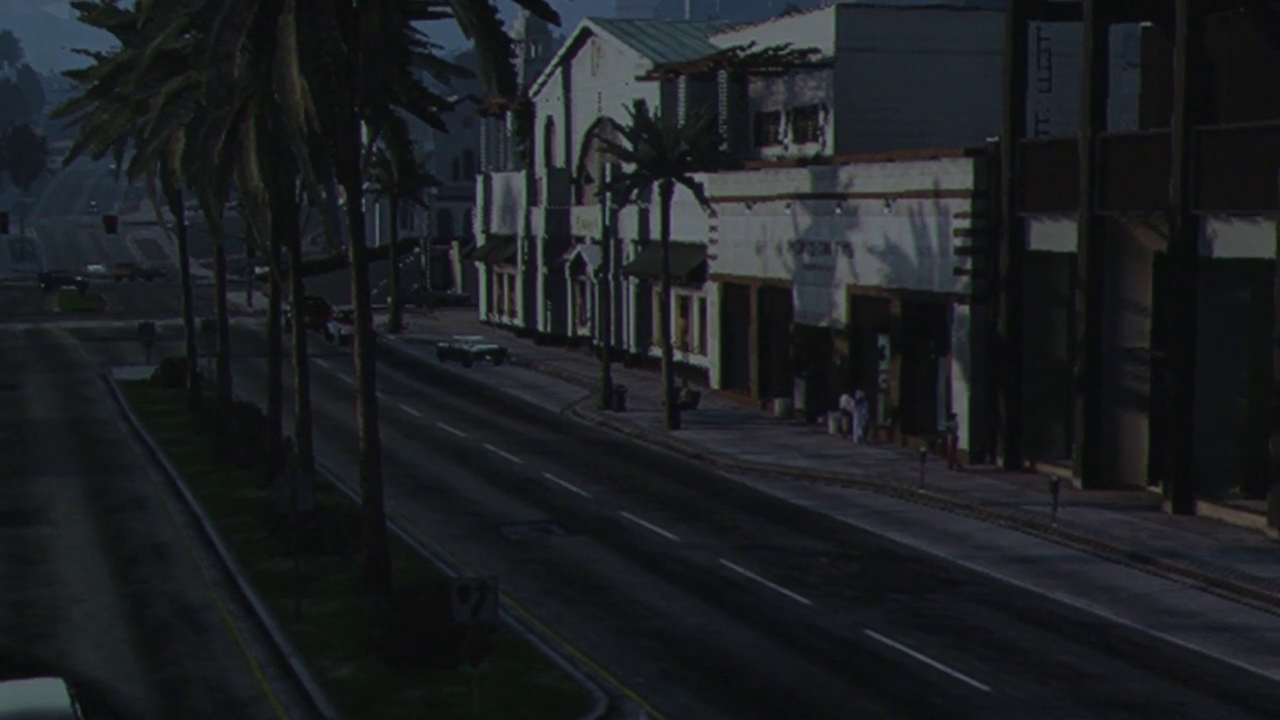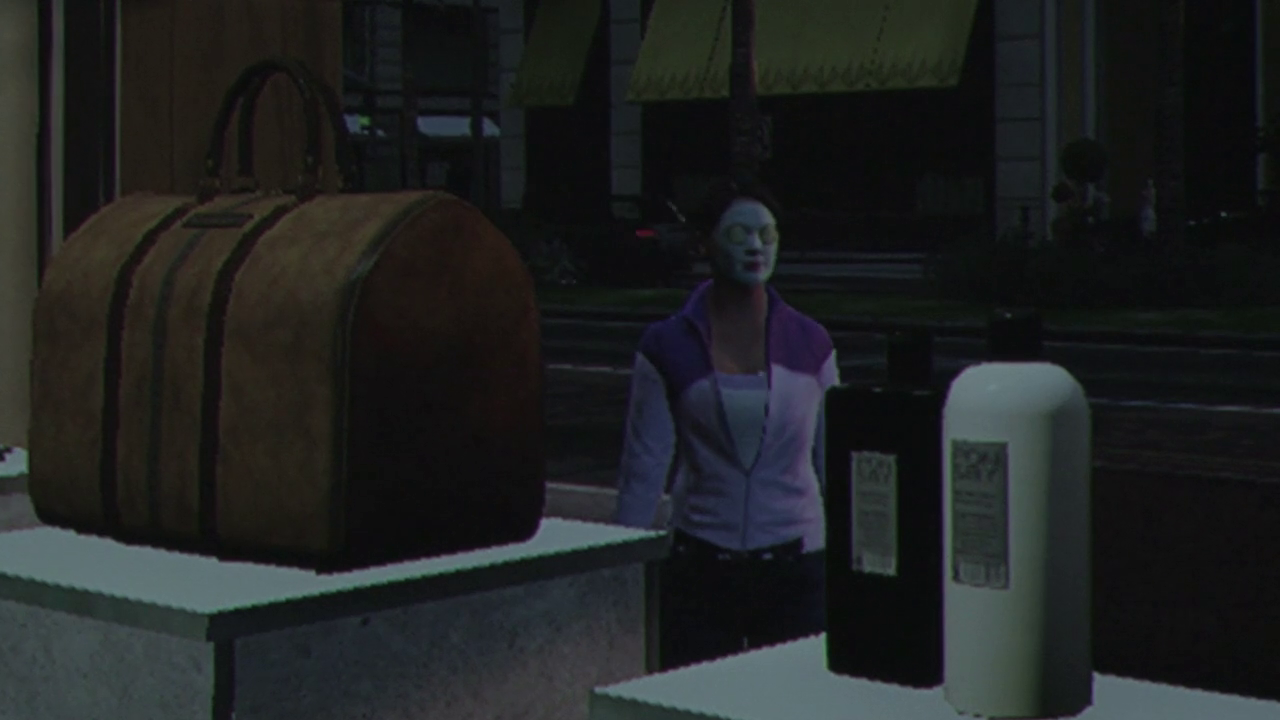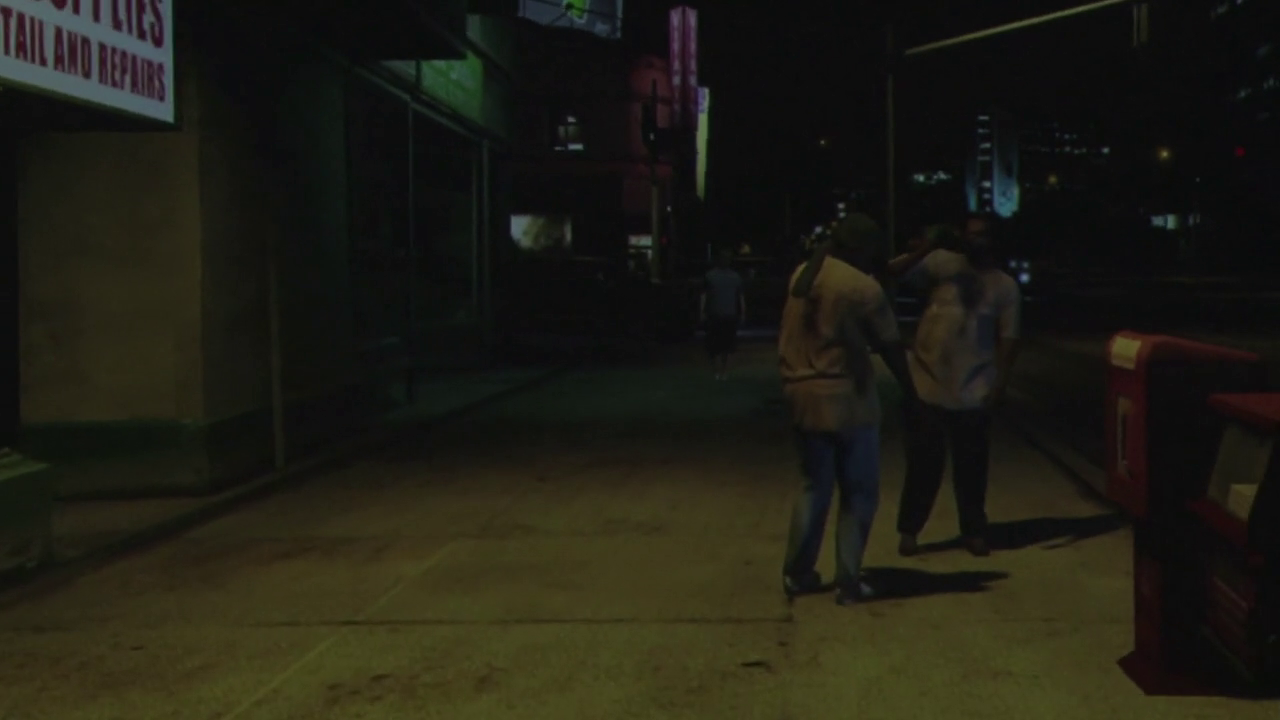IN BETWEEN IDENTITIES
digital video, color, sound, 8’ 50”, 2015, Germany
Created by Aleksandar Radan
In an ersatz Los Angeles permeated by a pervasive sense of dread, mysterious figures confront their own meaninglessness. Scantily dressed, completely naked or donning fur coats, men and women seem disoriented as they try to see more, see better or see nothing at all. Some even temporarily blind themselves with slices of cucumber over their eyes. At once recognizable and abstract, these cartoon-like characters are not pathetic, but rather apathetic. The viewer indulges in scopophilic pleasures as they perform mundane acts, like watching themselves in the mirror or taking a photo. It seems harmless, even comical, and yet one feels it could suddenly become a nightmare.
Aleksandar Radan was born in Offenbach am Main in 1988 and studied art at the Hochschule für Gestaltung in Offenbach. His work is concerned with the digital medium, especially video games, which he appropriates, manipulates, and subverts. Key themes include the unpredictable ruptures in otherwise predesigned behaviors and environments, the aesthetics of simulation, and the artist’s role in the age of algorithms. Radan’s practice includes experimental film/video, installation and performance. His works have been featured at multiple venues, including the Clermont-Ferrand International Short Film Festival and the International Short Film Festival in Oberhausen.
“[Video games] can reveal to us the dreams and fears that we do not yet know we have.” (Alfie Bown)
Matteo Bittanti: Can you describe your process? How did you create In between identities? I read in a previous interview that you were experimenting with a modification of Grand Theft Auto V. Was your artwork based on a preexisting script or did it develop organically and unpredictably, as you traversed the spaces of Los Santos? How much was planned and how much improvised?
Aleksandar Radan: I made the film in 2015. Since then it has been shown at various film festivals and exhibited as an installation in art galleries. I noticed that in all cases, curators inquire about the process and the technical aspects of the production. This is exciting because it indicates that they realize that this is not a “conventional” animation. Some even recognize locations or characters from the game. Personally, however, I don’t find this question particularly relevant. The technical aspect is all but secondary. After all, it is common nowadays to appropriate games and to use them as artistic material. What really matters to me is the poetic component – which is relatively unfiltered – that an artist can insert into an animated film. By using a game engine, you don’t have to work hours on one minute of animated content. It is a totally different workflow.
Matteo Bittanti: Many artists and filmmakers, including Harun Farocki (Parallel I-IV) have explored the uncanny nature of simulations and video games. Your work however, takes this feeling of comforting uneasiness, familiar strangeness, and ghastly mundanity to new heights. In your machinima, the avatars’ gestures, manners and poses appear simultaneously prosaic and burdened with grave meaning. This effect is achieved by an effective yet subtle use of the language of machinima, from extended shoots to unusual angles, not to mention the rough, cartoonish appearances of these digital personae. Moreover, the omission of a soundtrack projects something akin to an aura, an inexplicable gravitas, onto these puppets. Did you have a specific filmmaker or artist in mind when you began working on In between identities?
Aleksandar Radan: I did not have a specific artist in mind. Obviously, I have my “role models” but they don't necessarily have to be what we call artists. It can also be the nice granny sitting behind the counter who makes coffee at the local bakery. It may have inspired me to make some things look like they do in the final cut. My goal was to recreate a feeling, a sensation that I felt when I originally came in contact with virtual worlds as a young person. As children, we all played video games on consoles and later on computers, but I was never interested in the preassigned missions and tasks that a player must complete in order to advance. Rather, I was interested in the world that existed beyond the screen, a world that became somehow closer and closer to me in my dreams and thoughts. Today, a few years later, we’re all in the middle.
Matteo Bittanti: The appropriation and transformation of game content such as spaces, characters, and props for post-cinematic processes is not new. However, in the last two decades, machinima has clearly transcended the vernacular and merged with more avant-garde practices, as your work clearly demonstrates. What happens to a video game when it repudiates its origin as a form of entertainment? What is machinima to you?
Aleksandar Radan: At the moment, it is a tool that allows me to create a kind of “improvisation theater” on a digital stage. It is contemporary. The internet is full of kids who do nothing else. It is the stuff of my generation.
Matteo Bittanti: The dominant narrative (ideology?) of the video game medium is “freedom”. Players are “free” to do whatever they want, they can move “freely” in a virtual environment which is defined as a “space of possibility”. How “free” do video games appear to you, as an artist?
Aleksandar Radan: :) just free as the wall is for a painter on which a bare canvas hangs.
Matteo Bittanti: What is your relationship to video games? In games, players are both actors and spectators: they are not like the quintessential film viewer who mostly indulges in scopophilic pleasures. Who is the player, then? What does she/he want? And how does she/he achieve that?
Aleksandar Radan: This is the question that builds up the tension of the work. You watch yourself and you will get surprised by yourself. Is this feeling comparable to dreaming? Perhaps that’s just what the player wants, to dream.
Matteo Bittanti: The avatar is a liminal entity, situated at the intersection of different realities, and yet existing only at surface level, i.e. the screen. The avatar is not just a face, but mostly functions as an interface, as the player – the puppet master – negotiates her/his intentions with the affordances and capabilities of the software/hardware. Avatars are empty, devoid of meaning, and yet they are highly expressive, in their own way. In this work, all the avatars seem lost, deranged, disoriented, and displaced. Are these feelings originating in the puppet master or are they glitches in the matrix, so to speak?
Aleksandar Radan: They are both, I would argue. They lost their task, their pre-programmed goal, and I am catching them right at this moment. Even more, I’m trying to carry them through this world in which they are now disconnected. Of course, the puppet master is also part of this shift.
Matteo Bittanti: In between identities is a lucid commentary on our current media obsession: several scenes feature screens of some kind, from tv sets to smartphones. Characters are reflected onto many surfaces, including (broken) mirrors, store windows and displays. Their personalities are not simply split, but shattered and fragmented. Are they placeholders for our identities in an age of hypermediation?
Aleksandar Radan: Maybe more pioneers than placeholders?
Matteo Bittanti: There’s a character, in the latter part of the film, walking around with cucumber slices on her eyes. Is (temporary) blindness the only antidote to an excess of seeing? An overabundance of images and projections?
Aleksandar Radan: The cucumber slices don’t seem to bother the figure, she looks around and inspects the environment. At the end, she flies over the city with her couch and enjoys the view and the wind. For me, the cucumber slices mean exactly that. Apparently they prevent you from seeing, but ultimately they do not.
Matteo Bittanti: In his last book, Mark Fisher wrote that the weird is a “sense of wrongness”, and that the “conviction that this does not belong is often a sign that we are in the presence of the new”. Also, the weird “opens up an egress between this world and others”. How would you define the meaning of weird, in relationship to your practice?
Aleksandar Radan: This is so clever and poetic. I almost don’t dare to answer :) I think the “weird” for me is something that has always been there and for some reason does not want to leave. The “weirdness” happens to me in those moments when I notice that the seemingly novel worlds have always been a part of me.
A closer look atIn between identities
In between identities
digital video (1280 x 720), color, sound (stereo), 8’ 50”, 2015, Austria
Created by Aleksandar Radan, 2015
Courtesy of Aleksandar Radan, 2020
Made with Gran Theft Auto V (Rockstar Games, 2013)


